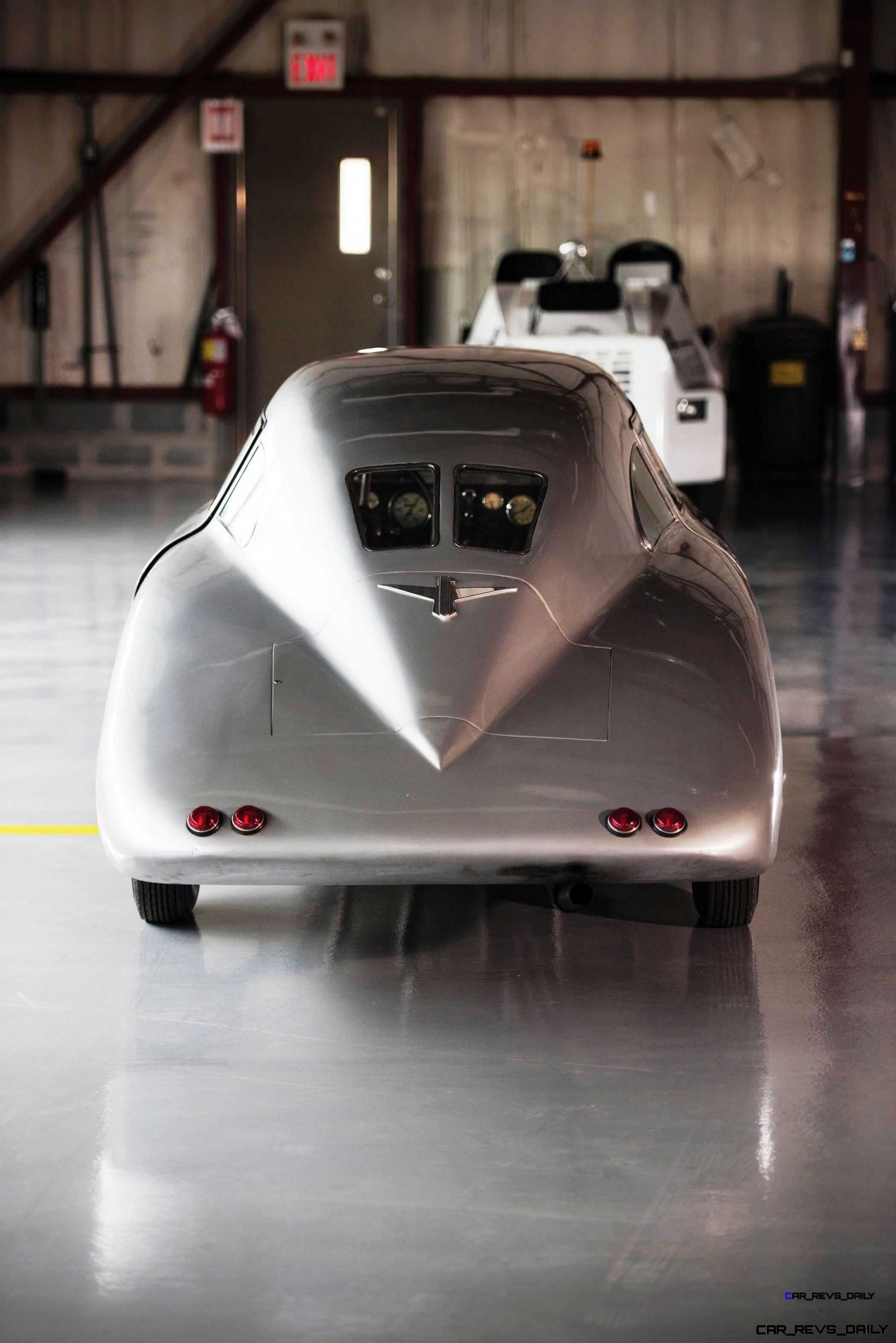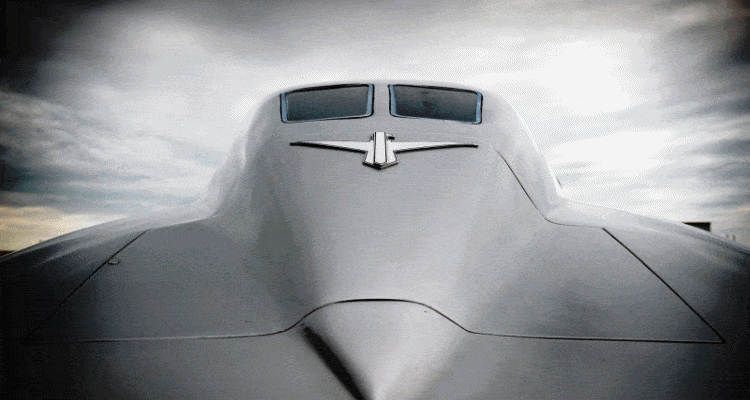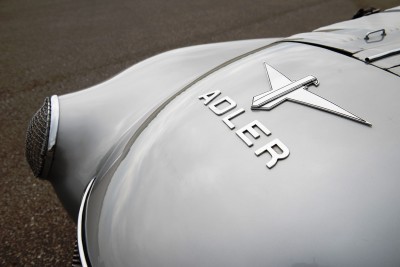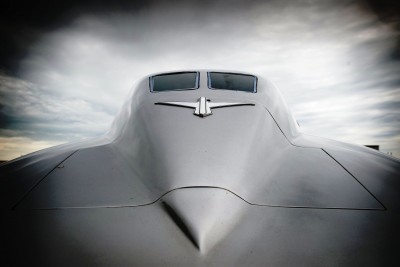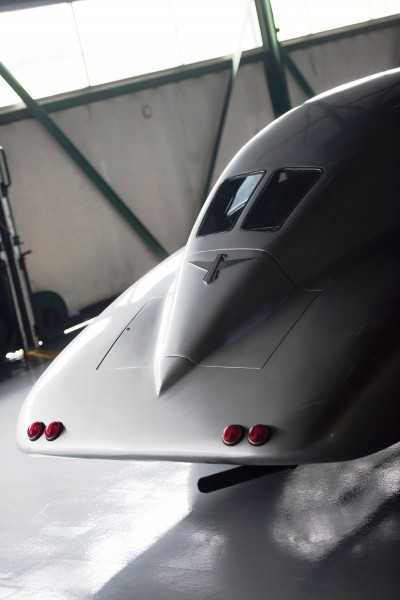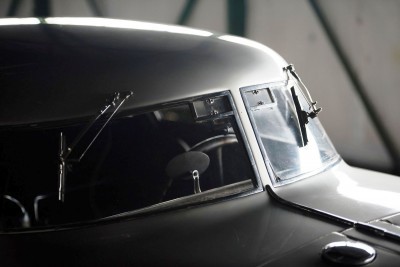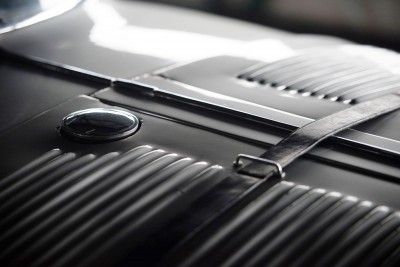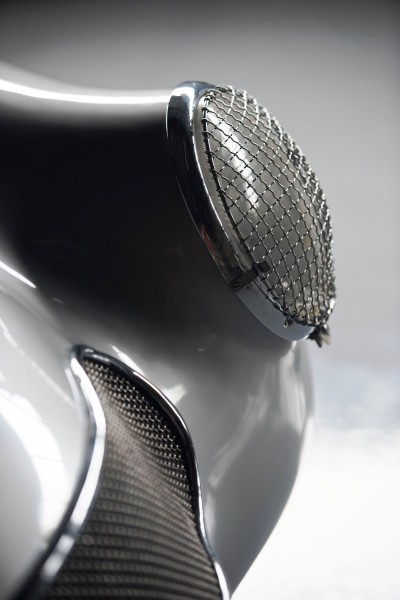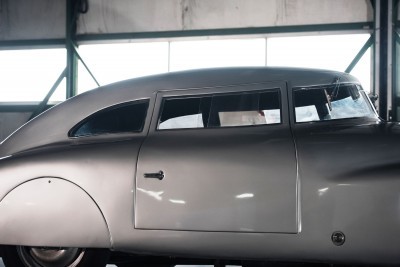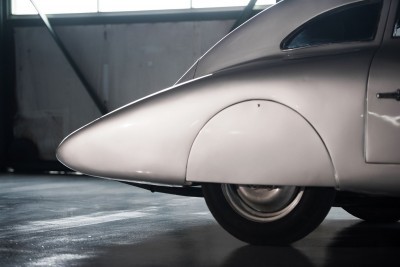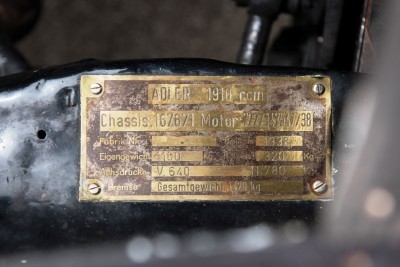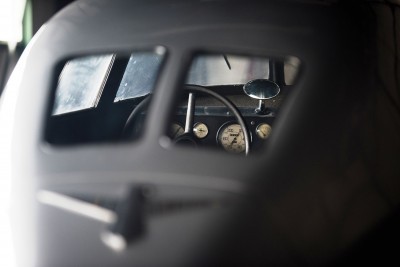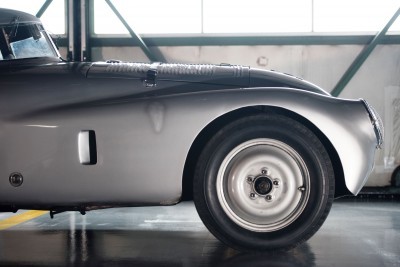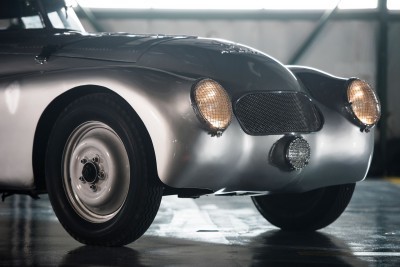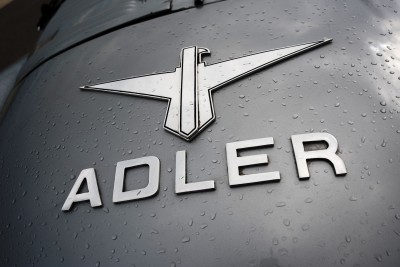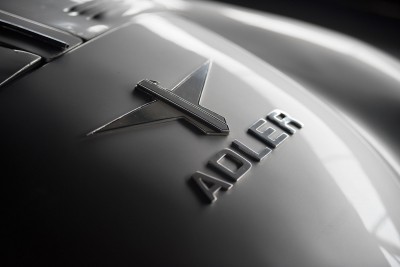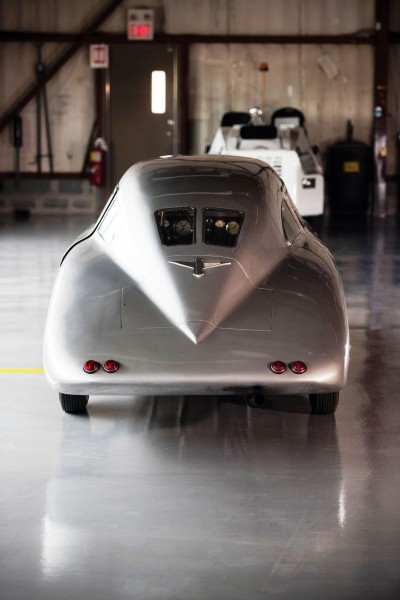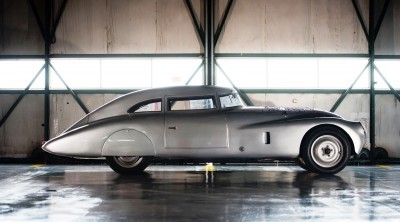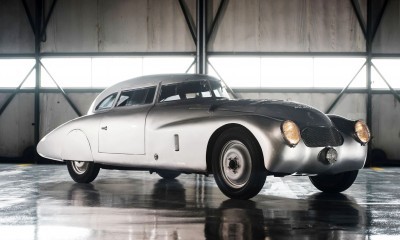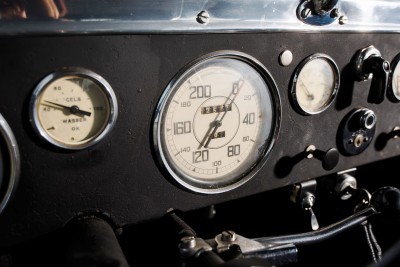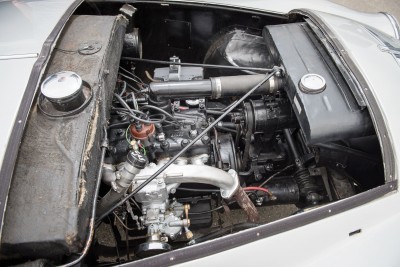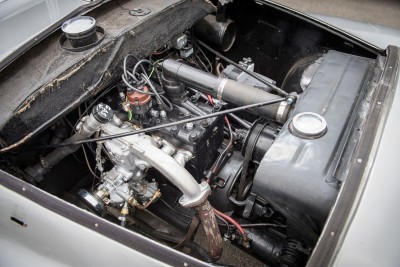 The fantastic convergence of aerospace and supercars has a glorious history! This Adler Trumpf Rennlimo from 1938 represented a fascinating view of automotive aerodynamics in a time before effective wind tunnels or computer simulations.
The fantastic convergence of aerospace and supercars has a glorious history! This Adler Trumpf Rennlimo from 1938 represented a fascinating view of automotive aerodynamics in a time before effective wind tunnels or computer simulations.
The learnings and design principles of aerodynamics were far more theoretical in the pre-jet age.
Yet Adler designers brought great insights from airship and Zeppelin design into the car world to great results. This ‘racing sedan,’ as the Rennlimo translates, was the first closed-cockpit racer to take on LeMans.
Just six were produced for sale, all with unique spindle and wing tweaks to the bodywork. The result is a sexy yet subtle mix of ultra pure and streamlined panels, plus a healthy bit of practicality included as well. With massive top speed potential but also a fairly large and plush cockpit, the Adler Trumpf Rennlimo was a wildcard among bigger Daimler-Benz vehicles of this style, like the 540K or even the BMW 328.
Intriguing elements of the teardrop glasshouse from the Adler Rennlimo show a striking preview of the C2 Corvette Sting Ray from 1962 — yet from a cool 25 years earlier.
The rarity and unique design — even among other Adlers — of this1938 Rennlimo makes it a potential all-star of RM Sotheby’s Monterey sale next month. Initial estimates have a floor of $1.2MM, and we’d estimate a solid $1.8MM to take this icon home.
1938 Adler Trumpf RennLimousine
RM Sotheby’s
Monterey
13-15 August 2015
1938 Adler Trumpf Rennlimousine
$1,200,000 – $1,800,000
- Chassis no. 167 671
- Engine no. 147 547/38
Photo Credit: Darin Schnabel ©2015 Courtesy of RM Sothebys
56 bhp, 1,910 cc inline four-cylinder engine, four-speed non-synchromesh manual transmission, independent front suspension, independent rear axle with quarter-elliptical cantilevered suspension, and four-wheel cable-actuated drum brakes. Wheelbase: 98.4 in.
- One of the first enclosed automobiles to race in the 24 Hours of Le Mans
- Incredibly modern design, including aerodynamic bodywork, front-wheel-drive, and independent suspension
- Formerly of the Brucker Family MovieWorld collection
- Exceptional authenticity, including its original engine and body panels
- Immense historic significance, comparable to the BMW Kamm Coupe and Mercedes-Benz 540 K Stromlinie
The name Adler is largely unknown in the United States, which is a shame, since this German manufacturer built some truly interesting automobiles prior to World War II. The company counted among its employees the great Hans-Gustav Röhr, who developed the innovative Trumpf automobile with a four-cylinder engine cooled by thermosiphon, a gravity-fed oil supply, all-round independent suspension, and front-wheel-drive. It was not a particularly fast car, with an engine putting out only about 56 brake horsepower, but aerodynamicist Paul Jaray figured out a way that it could be.
Jaray had been trained in airship design at a time when Germany was pioneering lighter-than-air flight. Having determined that the so-called “spindle” shape of an airship was ideally aerodynamic, Jaray cut it in half through the equator to form an automobile body. Further study determined that, in order to give the car stability, the “half-spindle” shape had to be tapered out into flat wings on either side of a tapered rear. The windshield was completely curved at almost 180 degrees to ideally direct air around the car rather than over it. The design was further refined, in an era before the widespread availability of wind tunnels, by means of threads attached to the body of a prototype; the prototype was then photographed at speed on the road and the body’s curves then adjusted to the paths of the threads—what engineers called “streamlines.”
THE RENNLIMOUSINES AND LE MANS
Adler took Jaray’s ideas and developed them into a Rennlimousine, or racing sedan, for the Trumpf chassis. At least six of these cars were produced in the late 1930s, each of which was a continuous evolution from the previous example. What the designs shared was the Jaray “half-spindle with wings” design, including a curved windshield. These cars were used extensively for testing, demonstrations, show appearances, and, especially, for record setting and racing.
According to historian Martin Schröder, chassis number 167 671, offered here, was probably the #34 car, one of three entered by the Works team in the 1937 24 Hours of Le Mans. Driven by Otto Löhr and Paul von Guilleaume in the 2-liter class, it finished 2nd in class and 9th overall. Schröder determined that this car then attended the Spa-Francorchamps 24 Hours in 1938, as number 32, driven by Sauerwein and Orssich and withdrawing following an accident. It was then rebuilt by the factory, with an amended front-end design, and given to the company’s foreign importers as a show car for demonstrations.
AFTER THE WAR
Unfortunately, the history of all Adler Trumpf Rennlimousines between 1939 and 1945 is not known. Chassis number 167 671 first appeared post-war in 1955 in Ansbach, in Northern Bavaria, and was registered to a German owner as AB 549-485 at the time. The car had acquired a split front bumper with the license plate in the center and two fog lights, hubcaps over the front wheels, and decorative aluminum strips on the nose and front fender openings, apparently to improve its usability on the street.
Sometime not long afterward, the Adler was exported to the United States and came into the ownership of Joe Gertler Sr., operator of the Raceway Garage in the Bronx and a noted racing car fabricator and mechanic of his time. Remarkably, of the three Rennlimousines that survived the war, Mr. Gertler would come to own two of them. Photographs supplied by his son, Joe Jr., indicate that this car was maintained by Mr. Gertler as acquired.
The Adler was later acquired by Jimmy Brucker, a well-known enthusiast and collector in Southern California. Mr. Brucker is widely remembered as a sponsor of numerous “kustom kulture” artists, including Von Dutch, Robert Williams, and Ed Roth, as well as a supplier of unusual antique automobiles to the film industry. Through his local studio connections, he assembled a fabulous collection of cars and film props, which was eventually opened to the public as MovieWorld Cars of the Stars and Planes of Fame, a museum in Buena Park, California. While on display at MovieWorld, the Adler was featured in the March 1974 issue of The Classic Car and as the cover feature of the December 1973 issue of Car Classics, in which it was erroneously attributed to Ferdinand Porsche!
Following MovieWorld’s closure, the Adler was acquired by Ken Behring’s Blackhawk Collection. The present owner acquired the car from the Blackhawk Collection in 1994 and has maintained it in his European collection ever since.
As restored for the Blackhawk Collection, the car had its 1950s German bumpers and fog light removed and was stripped and refinished appropriately in silver. Importantly, the car still has many of its original body panels, including both doors and the hood sections, all of which are numbered to match the chassis number. Similarly, the engine and chassis both still carry the original numbers known to belong to this car. While the original chrome trim is no longer present along the wheel arches, inspection inside of the arches reveals the row of studs originally used to attach the trim. Positive identification of this car as the #34 Le Mans car may be possible by removing the layers of paint and inspecting the original rivet holes throughout, leading to the tantalizing possibility of further investigation for a new owner.
One of only three surviving examples of the pioneering Rennlimousine, this car is almost certainly the most original and best preserved, with so much of its original form and features intact. Combined with an utterly fascinating and ahead-of-its-time chassis design and a large file of documented history, it makes for a remarkable automobile that is as impressive and otherworldly today as it would have been in 1937.
A comparable automobile to the inaccessible BMW Kamm Coupe and the Mercedes-Benz 540 K Stromlinie, this is the grandfather of every streamlined beauty that has followed its spirit down the Mulsanne Straight ever since.
Potential bidders are strongly encouraged to review this car’s extensive history file, available on-site at the Access the Knowledge desk or by contacting an RM Sotheby’s specialist.

Tom Burkart is the founder and managing editor of Car-Revs-Daily.com, an innovative and rapidly-expanding automotive news magazine.
He holds a Journalism JBA degree from the University of Wisconsin – Madison. Tom currently resides in Charleston, South Carolina with his two amazing dogs, Drake and Tank.
Mr. Burkart is available for all questions and concerns by email Tom(at)car-revs-daily.com.

